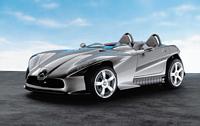Mercedes-Benz Shows F 400 With Active Camber Control
CHICAGO, Feb. 6 -- Mercedes-Benz is showing a special automotive study during press activities preceding the Chicago Auto Show. The F 400 research vehicle has been engineered to demonstrate future possibilities for substantially enhanced active safety, dynamic handling and driving pleasure. The Chicago Auto Show is open to the public February 8-17, 2002.
Active Camber Heightens Grip and Stability
Among the F 400's highlights is a new active system that tilts the wheels, varying the camber angle on the outer wheels between 0 and -20 degrees, depending on the road situation. Used in conjunction with newly developed tires, it provides 30 percent more lateral stability than a conventional system with fixed camber and standard tires. This enhances active safety, since better lateral stability equals improved grip and greater cornering stability. Active camber control boosts the research vehicle's maximum lateral acceleration to 1.28 g, a figure over 25 percent greater than today's best sports cars.
Active camber control paves the way for an equally new asymmetric-tread tire concept. When the two-seater F 400 corners, the outer wheels tilt inwards, leaving only the inner area of these tires in contact with the road. This area of the tire's tread is slightly rounded off, similar to motorcycle tires. The tread pattern and the rubber blend have been specially selected to ensure highly dynamic and extremely safe cornering. When driving straight ahead, however, the outer portion of the tires contact the road, providing excellent high-speed and low-noise performance. Two different concepts therefore come to fruition in a single tire, thanks to active camber control.
Less Risk of Skidding and Shorter Emergency Stopping Distances
As a mobile research laboratory, the Stuttgart-based automotive engineers will be using the F 400 to investigate the vast potential of this new chassis technology. Besides offering excellent directional stability during cornering, the new technology ensures a much higher level of active safety in the event of an emergency. For example, if there is a risk of skidding, wheel camber is increased accordingly. The resultant gain in lateral stability significantly enhances the effect of the Electronic Stability Program (ESP). If the research car needs to be braked in an emergency, all four of its wheels can be tilted in virtually no time, thus shortening the stopping distance from 62 mph by a whopping 16 feet.
Electronic Steering and ABC Active Suspension
In addition to active camber control, the F 400 research car is fitted with other forward-looking chassis systems, including an electronic steer-by- wire system. Sensors pick up the driver's steering inputs and send this information to two microcomputers that, in turn, control an electrically driven steering gear. The F 400 also charts new territory in suspension tuning by combining active camber control with a further development of ABC active suspension, the latter a Mercedes innovation standard in seven production models. This active suspension optimizes both springing and damping in line with changing road conditions, enabling excellent ride comfort with virtually no body roll under extreme cornering, and makes those adjustments at lightning speed.
Fiber Optic Headlights Point the Way
The F 400 also uses a totally new form of lighting technology. Fiber- optic lines transmit light from xenon lamps beneath the hood to the main headlamps. This technology provides high performance and allows space savings in packaging and design. Additional headlamps positioned on the vehicle's sides also illuminate when the car is cornering.
The F 400 is an exciting blend of technology and design. The shape of the sports car, and specifically, its distinctive fenders, provide the necessary room for the wheels to move when the active camber control is at work during cornering. They also emphasize the youthful and highly adventurous nature of this concept study. In order to reflect the research car's unusually high dynamic capabilities, a speedster concept incorporates an extended hood, a sharply-raked windshield, a short tail and an interior tailor-made for two.





